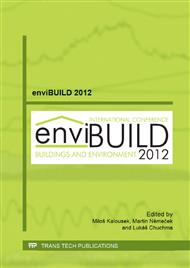p.3
p.7
p.11
p.15
p.19
p.25
p.29
p.33
Airtightness of Buildings in Slovakia
Abstract:
The actual trend of civil engineering leads to quality improving of housing and to saving of all participated energies. Airtightness of buildings´ envelope constructions has an important job in the point of view of energy savings and energy economy. Undesirable air flow occurs through joints, cracks and leaks in building envelopes. It has a significant influence to final quality of an indoor environment and energy demands and needs of warmth for heating resulting from it. The paper presents results of chosen airtightness measurements made in family and apartment buildings in the Slovak Republic, the achieved level of airtightness by various construction systems and outer walls, as well as which impact for air changes has location and selection of materials used for airtightness layer in the construction of outer walls at pressure difference of 50 Pa (n50).
Info:
Periodical:
Pages:
3-6
Citation:
Online since:
January 2013
Authors:
Keywords:
Price:
Сopyright:
© 2013 Trans Tech Publications Ltd. All Rights Reserved
Share:
Citation:


